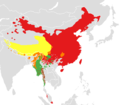File:Major Sino-Tibetan groups.png
Major_Sino-Tibetan_groups.png (471 × 414像素,文件大小:16 KB,MIME类型:image/png)
文件历史
点击某个日期/时间查看对应时刻的文件。
| 日期/时间 | 缩略图 | 大小 | 用户 | 备注 | |
|---|---|---|---|---|---|
| 当前 | 2021年6月9日 (三) 17:41 |  | 471 × 414(16 KB) | Sgnpkd | Korean area is overstated, refine Gansu areas, adding Chinese communities in Malaysia |
| 2021年6月9日 (三) 16:53 |  | 471 × 414(16 KB) | Sgnpkd | Extend the range of the Chin, Naga, Switch Jingpho, Kachin into orange, remove Tibetan range in uninhabited areas | |
| 2021年6月9日 (三) 16:35 |  | 471 × 414(16 KB) | Sgnpkd | remove Mandarin range in the unhabited desert & south Xinjiang to a more accurate range, adding Mandarin in Yili & Altay, adding the range of the Tujia people | |
| 2021年6月9日 (三) 16:25 |  | 471 × 414(16 KB) | Sgnpkd | 1] Repair previous error switch back southern Qiang(not Yi) into orange 2] adding the ranges of the Bai (orange), Nuosu Yi and Naxi people (Lolo), extend range of Tibetan languages to the border of northern and southern Qiang | |
| 2021年6月9日 (三) 16:16 |  | 471 × 414(16 KB) | Sgnpkd | Adding southern Yi ranges (see Yi people) switch the Liangshan Yi into green (which is Loloish) | |
| 2021年5月13日 (四) 19:12 |  | 471 × 414(14 KB) | Abdcd12312ew | Reverted to version as of 11:29, 2 August 2020 (UTC). There are significant inaccuracies in the current map in manchuria. The Han have an overwhelming majority in the region, in both cities and the countryside. Manchu is quite literally an endangered language. | |
| 2021年5月4日 (二) 19:58 |  | 471 × 414(16 KB) | Glennznl | Reverted to version as of 14:36, 22 February 2017 (UTC) Reverted to version before large simplifications | |
| 2020年8月2日 (日) 11:29 |  | 471 × 414(14 KB) | Ngguls | Almost no body speaks Tibetan in Xinjiang. Between Xinjiang and Tibet, the vast Qiangtang plateau is uninhabited. | |
| 2020年6月1日 (一) 04:33 |  | 471 × 414(15 KB) | Sharouser | Reverted to version as of 15:58, 17 November 2018 (UTC) There were no Sino-Tibetan speakers in Korea or Russia. | |
| 2019年4月27日 (六) 13:26 |  | 471 × 414(14 KB) | LenguaMapa | more what is chinese spoken area, mandarin is now majority language in all of inner mongolia and manchuria |
文件用途
全域文件用途
以下其他wiki使用此文件:
- bcl.wikipedia.org上的用途
- cdo.wikipedia.org上的用途
- de.wikipedia.org上的用途
- diq.wikipedia.org上的用途
- en.wikipedia.org上的用途
- et.wikipedia.org上的用途
- fa.wikipedia.org上的用途
- fr.wikipedia.org上的用途
- he.wikipedia.org上的用途
- incubator.wikimedia.org上的用途
- lfn.wikipedia.org上的用途
- mg.wikipedia.org上的用途
- ne.wikipedia.org上的用途
- sat.wikipedia.org上的用途
- simple.wikipedia.org上的用途
- sl.wikipedia.org上的用途
- sr.wikipedia.org上的用途
- tg.wikipedia.org上的用途
- tr.wikipedia.org上的用途
- ur.wikipedia.org上的用途
- uz.wikipedia.org上的用途
- zh-min-nan.wikipedia.org上的用途



